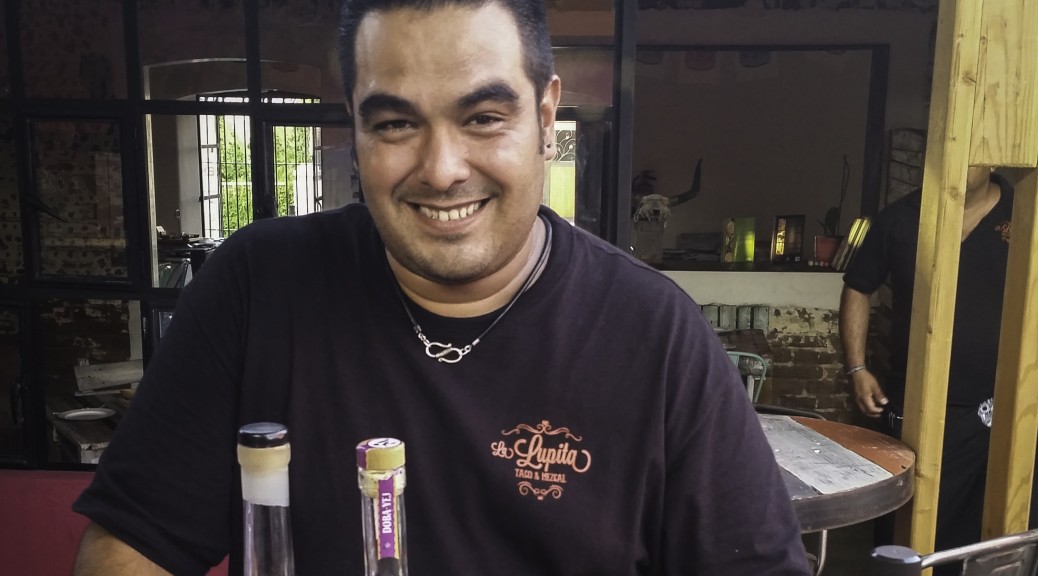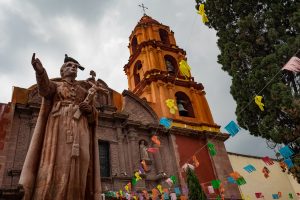Matt and I are in San Jose del Cabo for a couple of days. It’s a really cute little town that is really worth exploring. Sadly, it seems that most of the people who come here stay on the grounds of their all-inclusives and don’t bother to visit this gem of a town. There is great little art and foodie scene growing here with an organic market, lots of great art galleries featuring local Baja and Mexican artists, and really delicious restaurants.
Last night we stopped at La Lupita. It’s a relatively new place that specializes in tacos and mezcal. We were fashionably early for dinner – about 6:30 pm – but after a day at the beach, we were more interested in food than being cool. We sat on the back patio near the bar. The place is pretty great, brightly colored, back-yard-rustic, and pretty hip with a giant sugar skull on a bright pink wall staring down at everyone.
Stefano was our waiter and recommended two mezcal cocktails for us – the Tamarindo Martini, that Matt chose, and I had the Poquito Picante because it was made with Campari, which I love. After we ordered our drinks we saw that they offered two different mezcal flights. For dinner we each ordered two tacos. Matt ordered the traditional pastor taco and their barbacoa lamb. I chose the one made with spare ribs and the cochinita pibil taco. They were all delicious. We are really enjoying what the chefs in Mexico are doing to update the classics. The flavors and quality of ingredients are fantastic.
When we were done eating, Stefano asked if we were interested in anything else and mentioned that all the mezcals, including the flights were 2 for 1. How could we walk away from that? So, we ordered the two flights, one called “Artisinal” and the other, “Tradicional”. We have been learning about tequila and wanted to know more about mezcal. Flights are great for learning more about a particular spirit, especially if you have a great waiter and guide. We did.
Stefano brought out two trays, each with three bowls or drinking vessels carved out of light gourds and on the end an enameled bowl with ground hot peppers with a bit of salt and the other bowl with slices of orange. He then told us that the manager was going to come by our table.
Israel, the manager, walked over and started putting all of the bottles on the table – all 6 of them. Matt and I looked at each other and hoped that we would survive drinking all of that mezcal in one sitting. Israel was great. He went down the list, explaining to us a little bit about mezcal in general and about the ones that we would be tasting.
We learned that all tequilas are mezcal but not all mezcals are tequila. Tequila can only come from the blue agave, but mezcal can come from many types of agave and can be made of more than one type of agave in a single bottle, similar to a blended wine being made of different grapes. The most common type of agave that is used is espadín, which is from Oaxaca. About seven states in Mexico produce mezcal, but the owner of La Lupita is from Oaxaca, so his home state is heavily represented at his restaurant. The most prized, also from Oaxaca, are agaves that grow wild, such as the tobalá.
Mezcal also differs from tequila in the production process. Traditional or artisanal mezcal is produced in the following steps:
- The agave is harvested (usually at 8 years or older) and cut down to the piña or the heart.
- The hearts are then roasted in pits in the ground called hornos or palenques that are lined with stones or bricks. The hearts are layered between agave leaves and earth and roasted using oak or mesquite wood.
- Then the roasted agave is ground down using stone wheels.
- The ground agave is then left to ferment using natural yeasts from the plant itself and those that naturally occur in the air. If commercial yeasts are introduced, then it is not an artisanal or traditional mezcal.
- After the fermentation process, the mash is distilled 2 or more times over a period of at least 24 hours in copper stills.
Mezcal is aged, like tequila, but this seems to be a newer procedure. We have been told by a number of people that most Mexicans drink their mezcal joven and their tequila blanco – not aged. Oak barrels, used in the aging process, are expensive and mezcal and tequila are originally farmers’ drinks. In fact, while fermenting agave has been done for over 2000 years. Distilling it only came about during the Spanish colonialization in the 1600s. The aging in barrels is even more modern. Just like tequila there is reposado or rested mezcal (aged for 2 months to a year), añejo or aged from 1 to 3 years and extra añejo, but in mezcal this doesn’t mean anything specific other than more than 3 years. Please don’t ask about the worm. It’s not common and is usually used to mask the taste of crappy product.
We really enjoyed the mezcals that we tasted, each tasted so very different. We were most surprised that we enjoyed drinking them straight and not mixed into a cocktail. Like tasting wine, we worked our way down the line only this time we started with the sweeter mezcals, which are simpler, and worked our way to the more complex and balanced. Israel showed us a bottle that came from a batch that is only 50 litres (only 66 bottles made). The maestro mezcalista is a woman named Reyna Sánchez. One glass costs about $300 pesos (around $20 USD), too rich for our blood. Her photo, below, is from the side of the bottle. I would love to find her, try her mezcal, and get a photo, of course. She is beautiful!
It was a wonderful evening. Check out La Lupita if you ever go to San Jose del Cabo. Matt and I plan to continue our education of both tequila and mezcal when we get to the mainland, so watch this space for more.




Love your posting! When we were in Mexico (can’t remember where, though) we picked up a bottle of La Reliqula’s Crema de Mezcal. It’s vaguely analogous to Kahlua, and I’ve used it in place of Kahlua in beverages. This was my first (and only) contact with Mezcal, so thanks for the lesson!
Thanks for reading and for recommending the Creme de Mezcal. I was reading about it and look forward to trying it when we get to Oaxaca.
…now I’m hungry…and thirsty 😉
It was delicious. If you ever come down here, you’ll have to stop in for some tacos and fantastic cocktails!
I enjoyed your description of the place and people, and learning more about tequila and mezcal. I’ve never been to an all-inclusive in Mexico (or anywhere), but I imagine there’s a certain about of fear and trepidation about venturing out. It’s easy to believe stories about danger. I would hope that if I find myself with the opportunity, I’d be brave and adventurous 🙂
I’m glad that you enjoyed the blog post. It is too bad that there is fear because it is really safe. You won’t find any of the crime here in Baja that you hear about in the news. It’s like reading about a murder in New York City and being afraid of Napa Valley. As with all travel, keep your wits about you and don’t flash around money or expensive gear and you’ll have nothing to worry about in the majority of places. Especially here in Baja. I will say that we have not stayed at an all-inclusive either. I never saw the point of traveling to a wonderful place like Mexico and never actually visiting that place because you spend the whole time at the resort. The whole point of travel is to learn about new places and cultures. You can’t do that in a giant hotel.
You’ll travel soon. I know it. Just start planning something fantastic so when you can get away, you’ll have the perfect trip planned.
I also love San Jose. Although I do stay in an all-inclusive, I do venture out quite a bit. La Lupita is on the list for my next visit. Is it in the same block as the Baja Brewery?
Tom,
That’s fantastic! So many of the locals in San Jose were bemoaning the all-inclusives. I felt badly because places were pretty empty. You really must try La Lupita next time you are down there. It’s on Calle José María Morelos, so yes, on the same block as the brewing company.
-Neeley
I live in San Jose, but I’ve never heard of La Lupita’s. Can you tell us where it is exactly?
It’s directly across the street from La Osteria.
Thanks Kiya!
Yes, Jane, it’s there. On the same block as the Baja Brewing company. Their Facebook page is: https://www.facebook.com/lalupitatacoymezcal